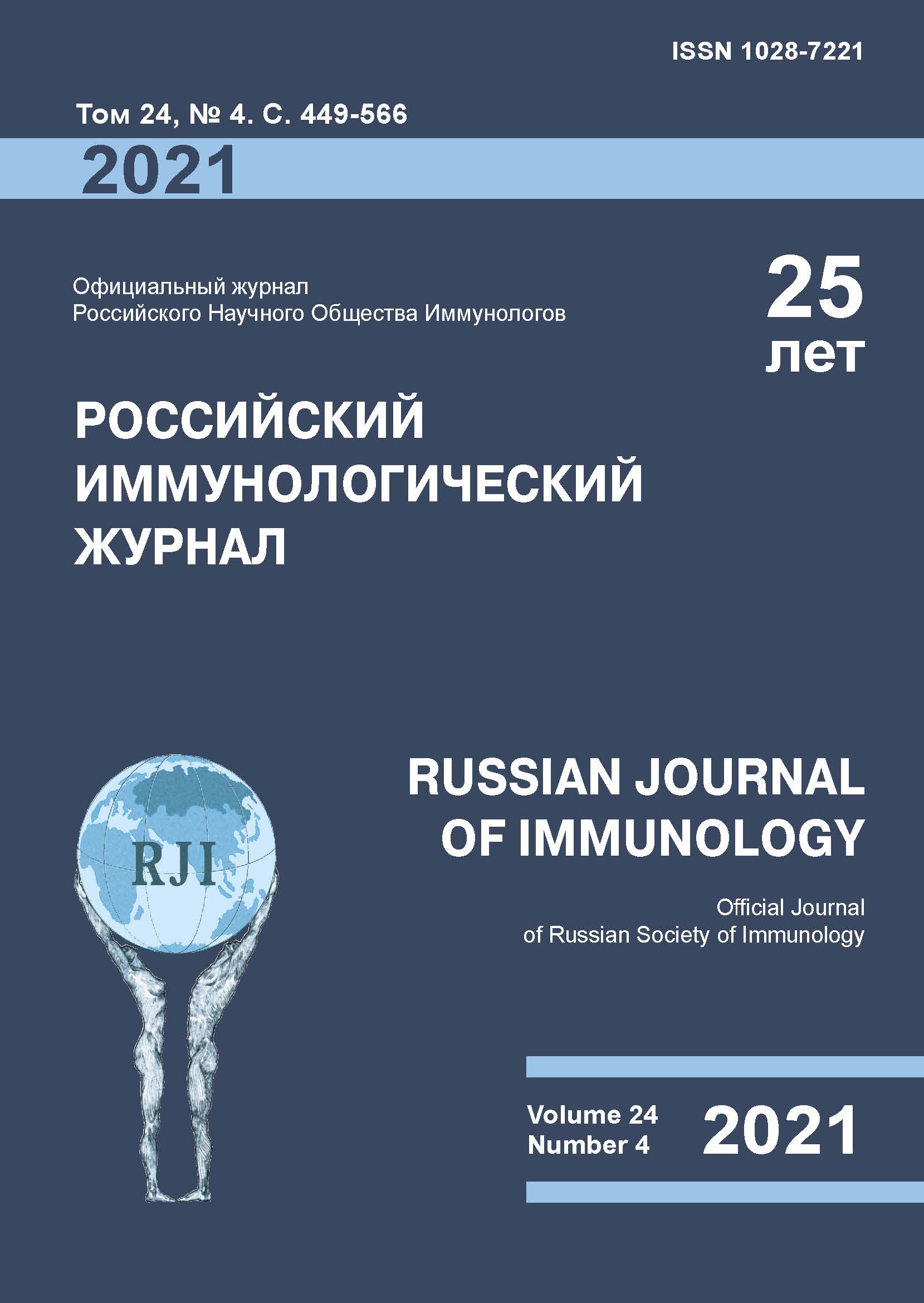Анализ экспрессии тканевого фактора на моноцитах у пациентов с сепсисом
- Авторы: Лазанович В.А.1, Маркелова Е.В.1, Шуматов В.Б.1, Постнова В.Е.1
-
Учреждения:
- ФГБОУ ВО «Тихоокеанский государственный медицинский университет» Министерства здравоохранения РФ
- Выпуск: Том 24, № 4 (2021)
- Страницы: 501-506
- Раздел: КРАТКИЕ СООБЩЕНИЯ
- Дата подачи: 28.07.2021
- Дата публикации: 15.10.2021
- URL: https://rusimmun.ru/jour/article/view/1071
- DOI: https://doi.org/10.46235/1028-7221-1071-EOT
- ID: 1071
Цитировать
Полный текст
Аннотация
Сепсис практически всегда связан с теми или иными нарушениями гемостаза. Факторами, выполняющими основную причинно-значимую роль в патогенезе данных процессов являются провоспалительные цитокины, эндотелий сосудов, тромбоциты, лейкоциты и экспрессированный на данных клетках тканевой фактор (tissue factor – TF), находящийся всегда в активном состоянии. Учитывая потенциальную связь системы коагуляции с патофизиологией сепсиса, TF можно рассматривать в качестве биомаркера для ранней диагностики, стратификации риска и оценки прогноза исхода заболевания при сепсисе. Цель – исследовать количественное содержание (CD14+CD142+) и уровень экспрессии TF на моноцитах у пациентов с сепсисом, проанализировать зависимость данных показателей от степени выраженности полиорганной дисфункции по шкале SOFA, исходов заболевания.
Было обследовано 67 пациентов с сепсисом. Степень тяжести полиорганной дисфункции/недостаточности оценивали по шкале – SOFA (Sepsis-related Organ Failure Assessments Score Sequential Organ Failure Assessment). Все пациенты были распределены на 2 группы с учетом тяжести состояния и выраженности органной недостаточности. 1-я группа (n = 30) – пациенты с диагнозом «сепсис» со степенью тяжести органной дисфункции < 6 баллов по шкале SOFA, 2-я группа (n = 37) – пациенты с диагнозом «сепсис» со степенью тяжести органной дисфункции > 6 баллов по шкале SOFA. Забор крови у пациентов проводился в первые 48 ч после поступления и установки диагноза. Исследовали количественное содержание (CD14+CD142+) и уровень экспрессии тканевого фактора на моноцитах методом проточной цитометрии.
Выявили, что содержание (CD14+CD142+) было существенно выше у пациентов сепсисом, чем у здоровых лиц (6,03±1,05%, против 0,24±0,02%, р = 0,001), с более тяжелой степенью органной дисфункции (SOFA) по сравнению с менее тяжелой (SOFA) (6,50±0,98% против 4,42±0,36%, р = 0,05). Высокий уровень экспрессии тканевого фактора на моноцитах прямо коррелировал r > 0,71 (p = 0,05) с тяжестью органной дисфункции (SOFA) и был сопряжен (р = 0,004) с летальным исходом заболевания. Данные результаты позволяют предположить, что экспрессия тканевого фактора на моноцитах может служить биомаркером, отражающим степень системного воспаления при сепсисе, быть критерием в прогнозе тяжести течения и исхода заболевания у пациентов с сепсисом.
Ключевые слова
Об авторах
В. А. Лазанович
ФГБОУ ВО «Тихоокеанский государственный медицинский университет» Министерства здравоохранения РФ
Автор, ответственный за переписку.
Email: immuno2003@mail.ru
ORCID iD: 0000-0003-0354-4890
канд. мед. наук, доцент кафедры нормальной и патологической физиологии
690062, Россия, г. Владивосток, пр. 100 лет Владивостоку, 14, кв. 49
Тел.: 8 (914) 703-45-09
РоссияЕ. В. Маркелова
ФГБОУ ВО «Тихоокеанский государственный медицинский университет» Министерства здравоохранения РФ
Email: markev2010@mail.ru
ORCID iD: 0000-0001-5846-851X
д-р. мед. наук, профессор, зав. кафедрой нормальной и патологической физиологии
690062, Россия, г. Владивосток, пр. 100 лет Владивостоку, 14, кв. 49
РоссияВ. Б. Шуматов
ФГБОУ ВО «Тихоокеанский государственный медицинский университет» Министерства здравоохранения РФ
Email: patphis-vl@mail.ru
ORCID iD: 0000-0002-9645-3471
д-р. мед. наук, профессор, зав. кафедрой реанимации, анестезиологии, интенсивной терапии и скорой медицинской помощи
690062, Россия, г. Владивосток, пр. 100 лет Владивостоку, 14, кв. 49
РоссияВ. Е. Постнова
ФГБОУ ВО «Тихоокеанский государственный медицинский университет» Министерства здравоохранения РФ
Email: valeeeriapost@gmail.com
ORCID iD: 0000-0001-8368-0993
студентка лечебного факультета
690062, Россия, г. Владивосток, пр. 100 лет Владивостоку, 14, кв. 49
РоссияСписок литературы
- Butenas S.T., Mann K.G. Tissue factor activity and function in blood coagulation. Thromb.Res., 2008, Vol. 122, Suppl. 1, pp. S42-S46.
- Butenas S.T., Mann K.G. Active tissue factor in blood? Nat. Med., 2004, Vol. 10, no. 11, рр. 1155-1156.
- de Jong H.K, van der Poll T., Wiersinga W.J. The systemic pro-inflammatory response in sepsis. J. Innate Immun., 2010, Vol. 2, no. 5, pp. 422-430.
- Ekdahl K.N., Teramura Y., Hamad O.A., Asif S., Duehrkop C., Fromell K. Dangerous liaisons: complement, coagulation, and kallikrein/kinin cross-talk act as a linchpin in the events leading to thromboinflammation. Immunol. Rev., 2016, Vol. 274, no. 1, pp. 245-269.
- Esmon C.T. The impact of the inflammatory response on coagulation. Thromb. Res., 2004, Vol. 114, no. 5-6, pp. 321-327.
- Gando S., Shiraishi A., Yamakawa K. Role of disseminated intravascular coagulation in severe sepsis. Thromb. Res., 2019, Vol. 178, pp. 182-188.
- Han P., Hanlon D., Arshad N., Lee J.S. Platelet P-selectin initiates cross-presentation and dendritic cell differentiation in blood monocytes. Sci. Adv., 2020, Vol. 11, no. 6, 1580. doi: 0.1126/sciadv.aaz1580.
- Levi M. Disseminated intravascular coagulation. Crit. Med., 2007, Vol. 35, pp. 2191-2195.
- Levi M., van der Poll T. Thrombomodulin in sepsis. Minerva Anestesiol., 2013, Vol. 79, рр. 294-298.
- Singer M., Deutschman S., Seymour C.W. The Third international consensus definitions for sepsis and septic shock (Sepsis-3). JAMA, 2016, Vol. 315. no. 8, pp. 801-810.
Дополнительные файлы







